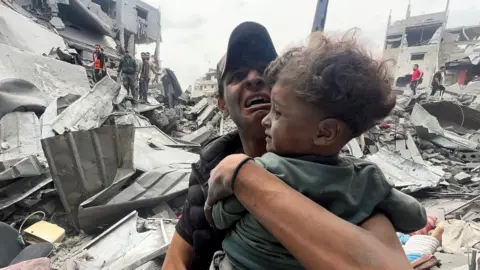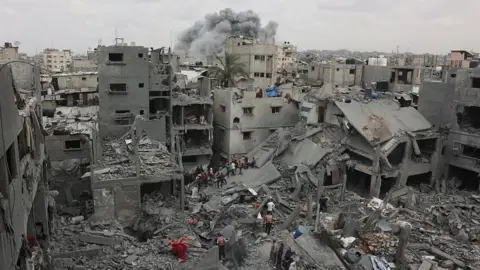 Reuters
ReutersAt least 29 Palestinians, including children, were killed in an Israeli air strike on a several floor residential building east of Gaza City, said a local hospital.
The Civil Defense Agency led by Hamas said that war planes have targeted the region near the Al-Hawashi mosque in the Shejaiya district on Tuesday morning.
He initially reported that 23 people had been killed, but warned that his first speakers were looking for two dozen other under the rubble. In the evening, he announced that 15 bodies had been recovered, without giving a number of updated deaths.
The Israeli army said that it had struck a “superior terrorist from Hamas” who was responsible for planning and executing attacks in the region.
Many measures have been taken to mitigate civilians’ damage, including the use of “precision weapons,” he added.
The soldiers also accused Hamas of having violated international law by deliberately using civilian population as human shields.
Shejaiya’s video has shown that bodies covered with dust of small children carried by the rubble by distraught parents and rescuers.
Ayub Salim, 26, told the AFP news agency that the area around the residential building struck on Tuesday morning was “overcrowded with tents, displaced people and houses”.
He said he had been touched by “multiple missiles” and that “bursts of shells stole in all directions”.
“Dust and mass destruction filled the whole place, we couldn’t see anything, just the cries and panic of the people,” he added. “It’s really a horrible massacre.”
Hamas also said that the Israeli army had “committed a bloody massacre”.
Thousands of residents of Shejaiya fled last week after the Israeli army ordered the evacuation of a large part of the district, claiming that it operated forcefully to destroy “terrorist infrastructures”.
But the residents said that the area struck on Wednesday was not covered by the evacuation order, many families had remained there.
“We were told that it was a safe area for the displaced, but they target residential blocks with fatal missiles. What did the children did? They did rockets in the Israeli army?” A man of Shejaiya told the Gaza Lifeline program of BBC Arabic.
 AFP
AFPEarlier Tuesday, the Ministry of Health managed by Gaza said that at least 33 people were killed in Israeli attacks in the previous 24 hours.
This brought the total reported of people killed since Israel resumed its air and land campaign against Hamas on March 18 to 1,482.
The Israeli army said that its planes had reached more than 45 “terrorist targets” in Gaza during the last day, including weapons manufacturing sites and rocket launchers.
He also said that land forces advanced in Shejaiya as well as the so-called “Morag corridor” in southern Gaza.
The military corridor is being created by seizing a territory between the city of Rafah, whose residents were ordered to evacuate, and Khan Younis Voisin.
During a visit to the region on Wednesday, the Israeli Defense Minister Israel Katz said: “We now settle through the strip, and we increase the pressure step by step, so that they (Hamas) give us our hostages.”
“Everything Rafah will be evacuated and transformed into a security zone. This is what we are doing now,” he added.
According to the Israeli army, 390,000 other people have been moved in the past three weeks, with two thirds of the territory now designated by the Israeli army as “without Go” areas or placed under evacuation orders, according to the UN.
The UN also warned that supplies of food, drugs and fuel have dried up because Israel has prevented any delivery of humanitarian aid for a month to put pressure on Hamas.
On Tuesday, secretary general António Guterres condemned the Israeli blockade, saying that he had violated international law and had opened “the valves of horror”.
“Gaza is a killing field and civilians are in an endless death loop,” he added.
The Israeli Ministry of Foreign Affairs rejected Guterres’ criticism, saying that he had “not let the facts embarrass themselves when they spread slander against Israel”.
“There is no shortage of humanitarian aid in the Gaza Strip-more than 25,000 aid trucks entered the Gaza Strip within 42 days of the ceasefire. Hamas used this aid to rebuild its war machine,” said spokesperson Oren Marmonstein.
On Monday, the heads of six humanitarian agencies of the United Nations described the assertion of Israel that there was enough food for 2.1 million people from Gaza as “far from reality on the ground”.
They called for the protection of civilians, the facilitation of aid deliveries, the release of the hostages held by Hamas and the renewal of the ceasefire.
Mediators continue to try to resuscitate the ceasefire, which started on January 19 and saw Hamas release 33 Israeli hostages – eight of them dead – and five Thai hostages in exchange for around 1,900 Palestinian prisoners and an increase in humanitarian aid by entering Gaza.
Israel said that he had resumed his offensive due to Hamas’ refusal to accept a proposal to extend the first phase of the ceasefire agreement and the release of more than the 59 hostages which he holds, up to 24, of which 24 are supposed to be alive.
Hamas accused Israel of having violated the initial agreement, according to which there would be a second phase where all the remaining living hostages would be handed over and the war has put permanent end.
The Israeli army launched a campaign to destroy Hamas in response to an unprecedented cross -border attack on October 7, 2023, in which around 1,200 people were killed and 251 were taken hostage.
Since then, more than 50,840 people have been killed in Gaza, according to the Ministry of Health in the territory.



